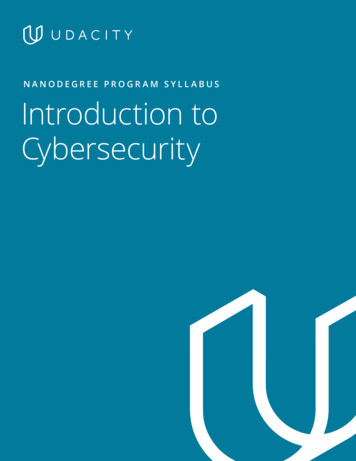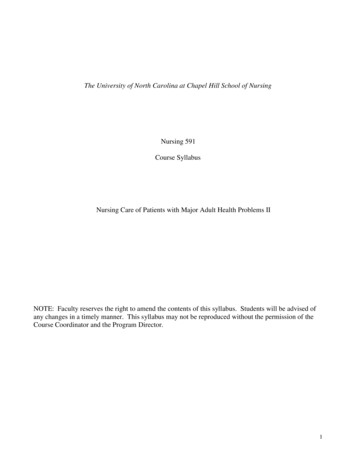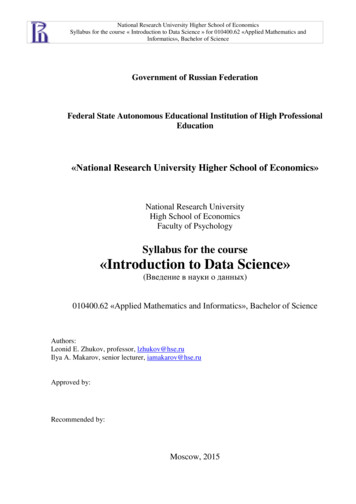
Transcription
NANODEGREE PROGR AM SYLL ABUSIntroduction toCybersecurityNeed Help? Speak with an Advisor: www.udacity.com/advisor
OverviewCybersecurity is a critically important field for businesses in every industry, especially given theproliferation of data breaches (more than 3.2 million records were compromised in the 10 biggest databreaches in the first half of 2020 alone). To reduce risk and improve security, businesses are rushing tohire for cybersecurity roles, yet there’s projected to be 3.5 million unfilled cybersecurity jobs by 2021.The Introduction to Cybersecurity Nanodegree program will equip you with the foundational skills to getstarted in this highly in-demand field.Graduates of this program will be able to: Evaluate specific security techniques used to administer a system that meets industry standardsand core controls. Explain methods for establishing and maintaining the security of a network, computingenvironment, and application. Apply control techniques to secure networks, operating systems, and applications. Conduct threat assessments and vulnerability scans to secure the assets of an organization. And much more!Estimated Time:4 months at10hrs/weekPrerequisites:Understand basicprinciples of networkconnectivity.Understand basicoperating systemfundamentalsincluding Windows orLinux.Flexible Learning:Self-pacedNeed Help?udacity.com/advisorNeed Help? Speak with an Advisor: www.udacity.com/advisorIntroduction to Cybersecurity 2
Course 1: Cybersecurity FoundationsSecurity is embedded in all we do online and is a critical job skill and career field. This foundations course explainssecurity fundamentals including core principles, critical security controls, and cybersecurity best practices.Students will also evaluate specific security techniques used to administer a system that meets industry standardsand core controls, assess high-level risks, vulnerabilities, and attack vectors of a sample system, and explain waysto establish and maintain the security of different types of computer systems.Course Final ProjectSecuring a BusinessNetworkIn this project, students will apply the skills they have acquired in thecybersecurity fundamentals course to conduct a hands-on securityassessment based on a common business problem. Students willinvestigate and fix security issues on a Windows 10 client systemas a way of demonstrating fundamental cybersecurity knowledge,skills, and abilities.LEARNING OUTCOMESLESSON ONELESSON TWOLESSON THREECybersecurityFundamentals Understand the relevant role of cybersecurity and whyit isimportant Describe how business stakeholders play a role incybersecurity Become familiar with cybersecurity tools, environmentsand dependenciesWhat isCybersecurity Identify trends in cybersecurity events and protectiontechniques Describe careers and skill qualifications of cybersecurityprofessionals Explain security fundamentals including core securityprinciples, critical security controls, and best practicesMaintain SecureInfrastructure Apply methods to enforce cybersecurity governance Identify common security regulations and frameworks Explain how current security laws, regulations, andstandards applied to cybersecurity and data privacy Recognize components of the NIST CybersecurityFramework (CSF) Recognize components of the Center for Internet SecurityCritical Security Controls (CSC)Need Help? Speak with an Advisor: www.udacity.com/advisorIntroduction to Cybersecurity 3
Think Like a Hacker Categorize assets, risks, threats, vulnerabilities, andexploits Identify different types of vulnerabilities in a system Identify the categories of a cyber threat Determine the phase of a cyber attack Recognize common exploitsLESSON FIVESecurity Defenses Explain how security defenses are layered throughoutdifferent system architectures Explain components of identity and access control Identify common identity and access control protectiontechniques Determine patch levels for common systems/applications Describe the process and technique for applying patchesand updates on computing devices Understand protection for email and other communicationmethodsLESSON SIXApplyingCybersecurity Identify organizational asset(s) Analyze vulnerabilities and risks to those organizationalassets Recommend and apply basic security controlsLESSON FOURNeed Help? Speak with an Advisor: www.udacity.com/advisorIntroduction to Cybersecurity 4
Course 2: Defending and Securing SystemsIn this course, students will be exposed to a diverse group of technologies that will provide or enhance theskills needed to enter the cybersecurity field. Students will apply best practices of Defense in Depth to securecomputer systems, use outputs from security incidents to analyze and improve future network security, andsearch internal systems to determine network vulnerabilities. Students will also learn how to recommendmitigations to address common application vulnerabilities and ensure fundamental encryption techniques forsecuring data at rest and in transit.Course Final ProjectMonitoring and SecuringDouglas Financials Inc.Douglas Financials Inc. (DFI) has experienced successful growthand as a result is ready to add a Security Analyst position. Acting asthat new analyst, students will analyze Windows and Linux serversand report recommendations on OS hardening, compliance issues,encryption, and network security. Students will also create firewallrules, analyze threat intelligence, and encrypt files and folders fortransport to a client.LEARNING OUTCOMESLESSON ONELESSON TWODefendingComputer Systemsand SecurityPrinciples Explain the Defense in Depth approach to a layeredsecurity strategy Explain the NIST 800 framework for defending computersystems Determine if a system has implemented Least Privilegedproperly Suggest approaches to correct systems that haveinappropriately implemented Least Privileged PrinciplesSystem Security:Securing Networks Differentiate between different types of firewalls Analyze the effectiveness of Firewall rules and craft a basic rule Evaluate best practices for securing wireless networks Explain different types of IDS/IPS and craft a basic IDSsignature Evaluate documentation to determine proper security settingsin Windows Identify the impact of services, permissions, and updates onWindows Security Identify the impact of daemons, permissions, and patches onLinux SecurityNeed Help? Speak with an Advisor: www.udacity.com/advisorIntroduction to Cybersecurity 5
LESSON THREELESSON FOURMonitoring andLogging forDetection ofMalicious Activity Interpret between different types of logs Define the basic parts of network traffic Interpret the output of a firewall and IDS report Explain the importance of a SIEM Explain the pros and cons of open source vs commercial SIEMCryptographyBasics (AppliedCryptography) Define encryption Differentiate different types of encryption techniques Determine the appropriate encryption type for a given scenario Differentiate between data at rest and data in transit Differentiate different types of encryption techniques for datain transit Define and analyze file hashesNeed Help? Speak with an Advisor: www.udacity.com/advisorIntroduction to Cybersecurity 6
Course 3: Threats, Vulnerabilities, and IncidentResponseCybersecurity breaches happen when a threat is able to successfully exploit a vulnerability within abusiness. To avoid these attacks, security professionals must understand threats the company is facing,including the various threat actors and their motivations. Security professionals must also be able to findvulnerabilities that can enable threats to attack through common practices such as vulnerability scanningand penetration testing. Finally, security professionals should be able to activate and follow incidentresponse procedures to address cybersecurity incidents and breaches. Ultimately, during this course,students will learn how to identify security threats and gaps, fix issues, and respond to inevitable attacks.Hospital X has seen its worst nightmare become a reality. Afterseveral hospitals in its partner network got hacked, the medicalestablishment has realized that it’s likely they are next on the attackhit list. In situations like this, it’s important for the cybersecurityteam to understand the threats at hand, whether the company isvulnerable, how to close the gaps, and ultimately how to respond ifthere is indeed a security incident.Course Final ProjectNavigating aCybersecurity IncidentIn this project, students will apply the skills they have acquiredin this security course to navigate a potential cyber incident.Students will work to identify the type of threat actor involved andpotential motivation behind the attack. Based on clues providedthroughout the scenario, students will conduct scans to discoverand test vulnerabilities that could lead to a successful attack.Students will then assess risk levels associated with the findingsand propose a remediation plan. They will also leverage a providedincident response plan to navigate the potential breach and makerecommendations for improvements to the plan.The final implementation of the project will showcase students’vulnerability management and incident response skills, includingtheir ability to prioritize threats and make recommendations to keystakeholders.Need Help? Speak with an Advisor: www.udacity.com/advisorIntroduction to Cybersecurity 7
LEARNING OUTCOMESLESSON ONEAssessing Threats Explain the relationship between threats, threat actors,vulnerabilities, and exploits Utilize event context to identify potential threat actormotivations. Identify security threats applicable to importantorganizational assets Use standard frameworks to assess threats, identify risks,and prioritizeLESSON TWOFinding SecurityVulnerabilities Leverage the MITRE ATT&CK framework to understand attackmethods Configure and launch scans to find vulnerabilities Explain the steps required to conduct a penetration test.Fixing SecurityVulnerabilities Conduct vulnerability research using industry resources likeMITRE CVE framework Validate scan results through manual testing and applicationof business context Prioritize security gaps and recommend remediationstrategiesPreparing forInevitable Attacks Explain the relationship between incident response, disasterrecovery, and business continuity Distinguish events from incidents and recognize indicatorsof compromise Explain the incident response lifecycle Recognize the key incident response team roles and corecomponents of an incident response planLESSON THREELESSON FOURNeed Help? Speak with an Advisor: www.udacity.com/advisorIntroduction to Cybersecurity 8
Course 4: Governance, Risk, and ComplianceCybersecurity Governance, Risk, and Compliance (GRC) has rapidly become a critical part of an effectivecybersecurity strategy. While it’s important to understand why, how, and where to apply cybersecurity controls,GRC connects cybersecurity controls to business objectives and serves as a safety net to ensure controls areapplied efficiently and effectively. In this course, students will learn about the functions of Governance, Risk,and Compliance and how each function operates alongside operational controls to strengthen an organization’ssecurity. Students will also learn how to assess control effectiveness, measure security risk, and ensure thatorganizations are meeting security compliance objectives.Course Final ProjectCreate the SwiftTech GRCProgramSwiftTech is a company in transition - they are accelerating productdevelopment while trying to maintain a high standard for flexibilityand responsiveness with customers, and doing all this while migratingtheir infrastructure to the cloud. This fast paced environment createschallenges for the organization’s cybersecurity GRC practice. As abrand new GRC analyst for SwiftTech, you’ll need to understand thebusiness quickly and improve their documentation to help supportthe organization’s goals.LEARNING OUTCOMESLESSON ONELESSON TWOLESSON THREEIntroduction toGovernance, Risk,and Compliance Understand the historical underpinnings ofcybersecurity GRC Explain the key functions of each of the Governance,Risk, and Compliance (GRC) roles Articulate the connection between GRC roles Demonstrate the importance of cybersecurity GRC inaccomplishing cybersecurity objectives and business goalsGovernance Understand reliance on governance professionals toalign business and security strategy. Describe how governance professionals are expected tocommunicate with the organization Develop organizational security policies and procedures Understand common methods for providing employeesecurity training Explain keys to assessing security controls againstexpected resultsRisk Explain how organizations measure cybersecurity risk Develop risk measurement documentation Remediate risk and report risk measurement andremediation activities to senior leadership Develop and interpret risk statements Understand the differences between value based riskassessment and traditional risk assessmentNeed Help? Speak with an Advisor: www.udacity.com/advisorIntroduction to Cybersecurity 9
LESSON FOURLESSON FIVECompliance Describe sources of compliance Locate and assess relevant sources of compliancefor your organization Interpret compliance obligations and develop controlobjectives Measure existing security controls against controlobjectivesAudit Management Understand audit and assessment goals Explain the role Governance, Risk, and Complianceprofessionals have in ensuring audits achieve expectedgoals Learn how to facilitate and control audits Develop management responses and remediation plansfor auditsNeed Help? Speak with an Advisor: www.udacity.com/advisorIntroduction to Cybersecurity 10
Our Classroom ExperienceREAL-WORLD PROJECTSBuild your skills through industry-relevant projects. Getpersonalized feedback from our network of 900 projectreviewers. Our simple interface makes it easy to submityour projects as often as you need and receive unlimitedfeedback on your work.KNOWLEDGEFind answers to your questions with Knowledge, ourproprietary wiki. Search questions asked by other students,connect with technical mentors, and discover in real-timehow to solve the challenges that you encounter.WORKSPACESSee your code in action. Check the output and quality ofyour code by running them on workspaces that are a partof our classroom.QUIZZESCheck your understanding of concepts learned in theprogram by answering simple and auto-graded quizzes.Easily go back to the lessons to brush up on conceptsanytime you get an answer wrong.CUSTOM STUDY PLANSCreate a custom study plan to suit your personal needsand use this plan to keep track of your progress towardyour goal.PROGRESS TRACKERStay on track to complete your Nanodegree program withuseful milestone reminders.Need Help? Speak with an Advisor: www.udacity.com/advisorIntroduction to Cybersecurity 11
Learn with the BestChristine Izuakor, PhD,CISSPF O U N D E R & C E O, C Y B E R P O P - U PDr. Christine Izuakor is the CEO of CyberPop-up, an on-demand cybersecurityplatform powered by vetted cyberfreelancers. She has over a decadeof experience leading cybersecurityfunctions within Fortune 100 companiesand has her PhD in Security Engineering.Jerry SmithI N F O R M AT I O N S E C U R I T Y E N G I N E E RJerry is a member of the SecurityOperations Center for the University ofAlabama Birmingham, where he is thelead Threat Hunter and a member ofthe firewall team. Previously he was anInformation Security Engineer for HibbettSporting Goods.Ron Woerner, CISSP, CISMSean Pike, Esq., M.S.CHIEF SECURIT Y OFFICERS R . D I R E C TO R , S E C U R I T Y & G R CRon Woerner is a noted consultant,speaker and writer in the security industry.As Chief Security Evangelist at Cyber-AAA,LLC, he delivers training and security riskassessments for small, medium, and largeorganizations. Woerner also teaches atBellevue University, an NSA Center ofAcademic Excellence.Sean Pike is a Cybersecurity and GRCleader with 20 years of experienceleading cybersecurity initiatives inregulated companies. Mr. Pike workswith organizations to develop unique,proactive security solutions that followstringent security principles whileaccelerating business.Need Help? Speak with an Advisor: www.udacity.com/advisorIntroduction to Cybersecurity 12
All Our Nanodegree Programs Include:EXPERIENCED PROJECT REVIEWERSREVIEWER SERVICES Personalized feedback & line by line code reviews 1600 Reviewers with a 4.85/5 average rating 3 hour average project review turnaround time Unlimited submissions and feedback loops Practical tips and industry best practices Additional suggested resources to improveTECHNICAL MENTOR SUPPORTMENTORSHIP SERVICES Questions answered quickly by our team oftechnical mentors 1000 Mentors with a 4.7/5 average rating Support for all your technical questionsPERSONAL CAREER SERVICESC AREER SUPPORT Resume support Github portfolio review LinkedIn profile optimizationNeed Help? Speak with an Advisor: www.udacity.com/advisorIntroduction to Cybersecurity 13
Frequently Asked QuestionsPROGR AM OVERVIE WWHY SHOULD I ENROLL?Cybersecurity is a critically important field for businesses in every industry,especially given the proliferance of data breaches (more than 3.2 millionrecords were compromised in the 10 biggest data breaches in the first halfof 2020 alone). To reduce risk and improve security, businesses are rushingto hire for cybersecurity roles, yet there’s projected to be 3.5 million unfilledcybersecurity jobs by 2021. The Introduction to Cybersecurity Nanodegreepprogram will equip you with the foundational skills to get started in this highlyin-demand field.Graduates of this program will be able to: Evaluate specific security techniques used to administer a system thatmeets industry standards and core controls. Explain methods for establishing and maintaining the security of anetwork, computing environment, and application. Apply control techniques to secure networks, operating systems, andapplications. Conduct threat assessments and vulnerability scans to secure the assetsof an organization.WHAT JOBS WILL THIS PROGRAM PREPARE ME FOR?While this is an introductory course that may not necessarily prepare you for aspecific job, it will prepare you with the right foundation with which to pursuemore specialized cybersecurity training. It also serves as a great supplementfor professionals in IT, Risk Management, and Consulting to bolster theircurrent skillset with a strong grasp of cybersecurity fundamentals.HOW DO I KNOW IF THIS PROGRAM IS RIGHT FOR ME?This program is a great fit for anyone interested in building fundamentalskills and knowledge in cybersecurity, such as system and network security,threat assessment, and incident response. Whether you’re looking to moveinto a career in the field of cybersecurity, or just want to improve your ownunderstanding of core cybersecurity skills, the Introduction to CybersecurityNanodegree program is for you.ENROLLMENT AND ADMISSIONDO I NEED TO APPLY? WHAT ARE THE ADMISSION CRITERIA?No. This Nanodegree program accepts all applicants regardless of experienceand specific background.Need Help? Speak with an Advisor: www.udacity.com/advisorIntroduction to Cybersecurity 14
FAQs ContinuedWHAT ARE THE PREREQUISITES FOR ENROLLMENT?To be best prepared to succeed in this program, students should have basicfamiliarity or experience with: Principles of network connectivity Basic operating system fundamentals including Windows or LinuxIF I DO NOT MEET THE REQUIREMENTS TO ENROLL, WHAT SHOULD I DO?We recommend this Linux Command Line Basics course if you’d like to learnmore about the Linux OS.TUITION AND TERM OF PROGR AMHOW IS THIS NANODEGREE PROGRAM STRUCTURED?The Introduction to Cybersecurity Nanodegree program is comprised ofcontent and curriculum to support four projects. Once you subscribe to aNanodegree program, you will have access to the content and services for thelength of time specified by your subscription. We estimate that students cancomplete the program in four months, working 10 hours per week.Each project will be reviewed by the Udacity reviewer network. Feedback willbe provided and if you do not pass the project, you will be asked to resubmitthe project until it passes.HOW LONG IS THIS NANODEGREE PROGRAM?Access to this Nanodegree program runs for the length of time specified inthe payment card above. If you do not graduate within that time period, youwill continue learning with month to month payments. See the Terms of Useand FAQs for other policies regarding the terms of access to our Nanodegreeprograms.CAN I SWITCH MY START DATE? CAN I GET A REFUND?Please see the Udacity Program Terms of Use and FAQs for policies onenrollment in our programs.S O F T WA R E A N D H A R D W A R E - W H AT D O I N E E D F O R T H I S P R O G R A M ?WHAT SOFTWARE AND VERSIONS WILL I NEED IN THIS PROGRAM?For this Nanodegree program, you will need a desktop or laptop computerrunning recent versions of Windows, Mac OS X, or Linux and an unmeteredbroadband Internet connection.Need Help? Speak with an Advisor: www.udacity.com/advisorIntroduction to Cybersecurity 15
Evaluate specific security techniques used to administer a system that meets industry standards and core controls. Explain methods for establishing and maintaining the security of a network, computing environment, and application. Apply control techniques










